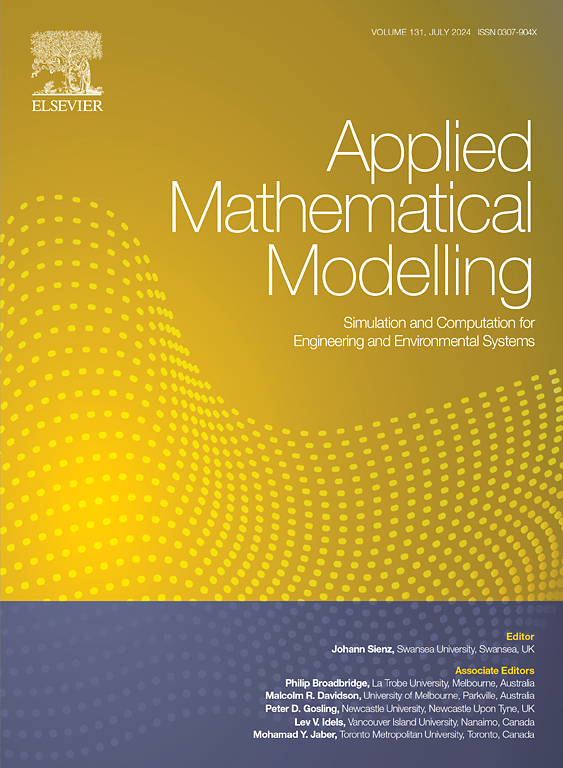Least-squares stabilized collocation method for the parameter identification in transient inverse heat conduction problems
IF 4.4
2区 工程技术
Q1 ENGINEERING, MULTIDISCIPLINARY
引用次数: 0
Abstract
The inverse heat conduction problem (IHCP) has significant applications across multiple disciplines. Traditional methods for IHCPs often require tedious and low-accuracy iteration, which frequently fails to meet engineering demands. Therefore, developing highly efficient and accurate methods for IHCP solutions is required. A novel meshfree least-squares stabilized collocation method (LSCM) for solving transient IHCPs is proposed in this paper. LSCM uses subdomain integration to incorporate physical information on Gauss points into the collocation equations, which enhances accuracy and stability of solution. The least-squares scheme is implemented to avoid the iteration process for overdetermined problems arising from multiple measurement conditions. To address the non-linear characteristics of transient IHCPs, an integral transformation that linearizes the governing equations is introduced in LSCM, which avoids the iteration for nonlinear problems and improves efficiency. Convergence analysis of the proposed LSCM indicates that optimal accuracy can be achieved with appropriate weights on the boundaries and additional conditions. Stability analysis demonstrates that the LSCM provides robust stability for the time integration process of IHCPs. Dispersion analysis shows that the LSCM possesses small dispersion errors and good stability. Finally, numerical examples demonstrate that the proposed LSCM yields reliable parameter solutions even when input data includes up to 10 % and 20 % noise, with convergence rates reaching 1.5 and 0.7, respectively (compared to 1.8 without noise). Additionally, the identification of a source control parameter in a 3D cooling tower model further showcases the method's strong capability in handling complex engineering scenarios.
瞬态反热传导问题参数辨识的最小二乘稳定配点法
逆热传导问题(IHCP)在多个学科中具有重要的应用。传统的IHCPs方法往往需要繁琐且精度低的迭代,往往不能满足工程需求。因此,需要开发高效、准确的IHCP溶液方法。提出了一种求解瞬态IHCPs的无网格最小二乘稳定配点法。LSCM采用子域积分法将高斯点的物理信息融入到配配方程中,提高了配配方程求解的精度和稳定性。采用最小二乘格式,避免了多测量条件下的过定问题的迭代过程。针对瞬态IHCPs的非线性特性,在LSCM中引入了对控制方程进行线性化的积分变换,避免了非线性问题的迭代,提高了求解效率。收敛性分析表明,采用适当的边界权值和附加条件可以达到最优精度。稳定性分析表明,LSCM对IHCPs的时间积分过程具有鲁棒稳定性。色散分析表明,LSCM具有较小的色散误差和良好的稳定性。最后,数值实例表明,即使输入数据包含高达10%和20%的噪声,所提出的LSCM也能产生可靠的参数解,收敛率分别达到1.5和0.7(与无噪声的1.8相比)。此外,在三维冷却塔模型中识别源控制参数进一步展示了该方法在处理复杂工程场景方面的强大能力。
本文章由计算机程序翻译,如有差异,请以英文原文为准。
求助全文
约1分钟内获得全文
求助全文
来源期刊

Applied Mathematical Modelling
数学-工程:综合
CiteScore
9.80
自引率
8.00%
发文量
508
审稿时长
43 days
期刊介绍:
Applied Mathematical Modelling focuses on research related to the mathematical modelling of engineering and environmental processes, manufacturing, and industrial systems. A significant emerging area of research activity involves multiphysics processes, and contributions in this area are particularly encouraged.
This influential publication covers a wide spectrum of subjects including heat transfer, fluid mechanics, CFD, and transport phenomena; solid mechanics and mechanics of metals; electromagnets and MHD; reliability modelling and system optimization; finite volume, finite element, and boundary element procedures; modelling of inventory, industrial, manufacturing and logistics systems for viable decision making; civil engineering systems and structures; mineral and energy resources; relevant software engineering issues associated with CAD and CAE; and materials and metallurgical engineering.
Applied Mathematical Modelling is primarily interested in papers developing increased insights into real-world problems through novel mathematical modelling, novel applications or a combination of these. Papers employing existing numerical techniques must demonstrate sufficient novelty in the solution of practical problems. Papers on fuzzy logic in decision-making or purely financial mathematics are normally not considered. Research on fractional differential equations, bifurcation, and numerical methods needs to include practical examples. Population dynamics must solve realistic scenarios. Papers in the area of logistics and business modelling should demonstrate meaningful managerial insight. Submissions with no real-world application will not be considered.
 求助内容:
求助内容: 应助结果提醒方式:
应助结果提醒方式:


